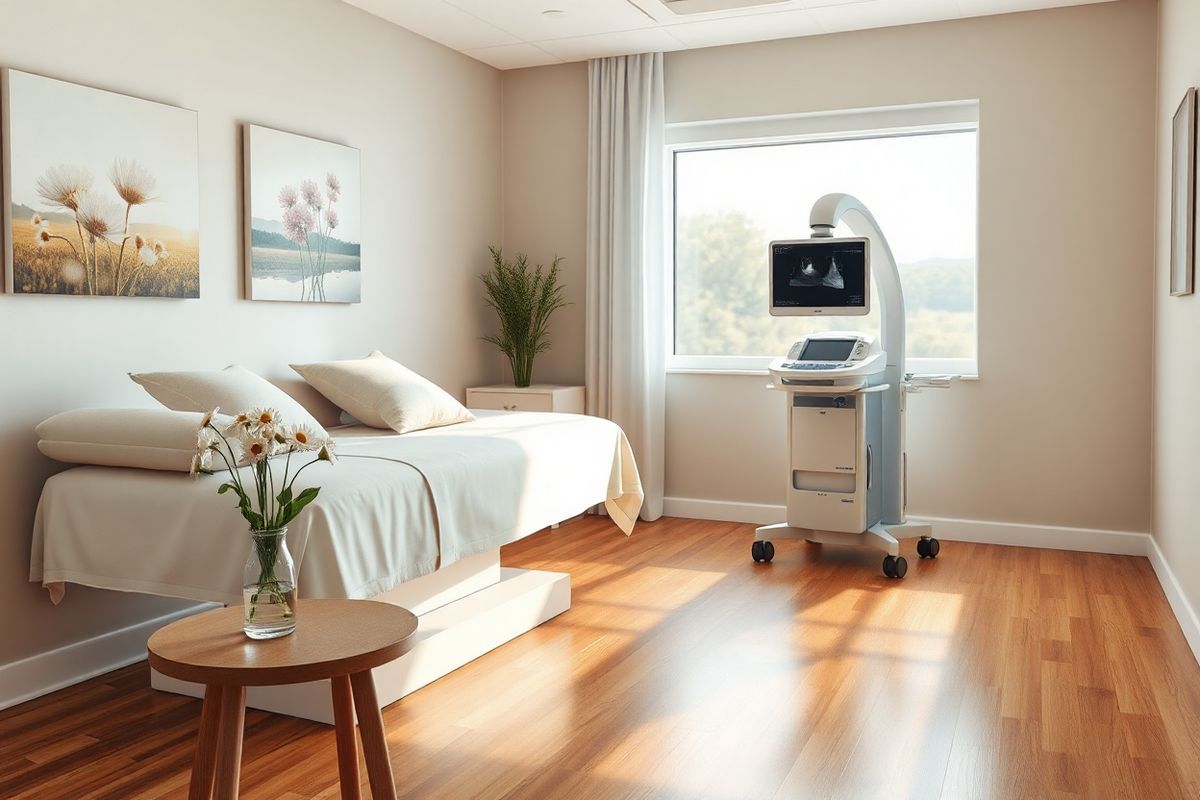Table of Contents
Common Noncancerous Breast Conditions and Their Symptoms

Noncancerous breast conditions can manifest in various ways, often presenting symptoms that may mimic those of breast cancer. Some of the most common benign breast conditions include:
-
Breast Cysts: These are fluid-filled sacs that can develop in the breast tissue. Cysts may feel tender and can fluctuate in size with the menstrual cycle. They are most common in women aged 35 to 50 and often become painful just before menstruation (Cleveland Clinic, n.d.).
-
Fibroadenomas: These are solid, smooth, and rubbery lumps that are most commonly found in women aged 15 to 35. Fibroadenomas are noncancerous and typically do not increase the risk of breast cancer (Cleveland Clinic, n.d.).
-
Fibrocystic Breast Changes: This condition is characterized by lumpy or rope-like breast tissue and is often accompanied by breast pain. It is common in women aged 30 to 50 and is influenced by hormonal fluctuations (Cleveland Clinic, n.d.).
-
Hyperplasia: An overgrowth of breast tissue may be classified as usual or atypical hyperplasia. Usual hyperplasia does not significantly increase cancer risk, while atypical hyperplasia can elevate the risk of developing breast cancer in the future (Cleveland Clinic, n.d.).
-
Intraductal Papillomas: These small, wart-like growths occur inside the breast ducts and may cause nipple discharge. They are typically benign but may increase the risk of breast cancer if multiple papillomas are present (Cleveland Clinic, n.d.).
-
Mastitis: This is an inflammation of the breast tissue that can occur during breastfeeding. Symptoms include pain, swelling, redness, and sometimes fever. Mastitis is usually caused by infection from blocked milk ducts or bacteria entering through a crack in the skin (Brigham and Women’s Hospital, n.d.).
Understanding these conditions and their symptoms is crucial for early detection and management.
How Cysts and Fibroadenomas Differ from Breast Cancer

While breast cysts and fibroadenomas are common benign conditions, they differ significantly from breast cancer.
-
Breast Cysts: These are typically round or oval lumps that can be soft or firm, filled with fluid, and are generally painless unless they rupture. Cysts often go away on their own, especially after menopause (Cleveland Clinic, n.d.).
-
Fibroadenomas: These lumps are solid and can feel smooth and rubbery. They may change in size but do not usually cause pain. Unlike cysts, fibroadenomas are composed of both glandular and fibrous tissue and may require monitoring or surgical removal if they grow too large. Importantly, fibroadenomas are not linked to an increased risk of breast cancer (Cleveland Clinic, n.d.).
In contrast, breast cancer typically presents as a hard lump that is often painless and may have irregular edges. Unlike benign lumps, cancerous lumps usually do not change in size with hormonal fluctuations and may be accompanied by additional symptoms such as skin changes, discharge, or changes in the shape of the breast (Brigham and Women’s Hospital, n.d.).
The Link Between Benign Breast Conditions and Cancer Risk
Although benign breast conditions are not cancerous, some can be associated with an increased risk of developing breast cancer.
-
Atypical Hyperplasia: This condition can increase breast cancer risk, particularly if the cells appear abnormal under a microscope. Women diagnosed with atypical hyperplasia may be advised to undergo closer monitoring and consider preventive measures (Benign Breast Conditions, 2022).
-
Usual Hyperplasia: This is less concerning than atypical hyperplasia; however, it can still indicate a higher risk of breast cancer compared to women without hyperplasia (Brigham and Women’s Hospital, n.d.).
-
Lobular carcinoma In Situ (LCIS): Although classified as a benign condition, LCIS indicates an increased risk for developing breast cancer in either breast. Women with LCIS should discuss their risk management strategies with their healthcare provider (Cleveland Clinic, n.d.).
It is essential for women with benign conditions, especially those with atypical hyperplasia or LCIS, to engage in regular screening and monitoring to catch any potential changes early.
Recognizing the Signs: When to Seek Medical Attention for Breast Changes
Not all breast changes warrant immediate medical attention, but certain symptoms should prompt a visit to a healthcare provider. These include:
- Persistent lumps that do not go away or change in size.
- Lumps that are painful or accompanied by swelling.
- Changes in the shape or contour of the breast.
- Nipple discharge that is not related to breastfeeding, especially if it is bloody or clear.
- Redness, warmth, or irritation of the breast skin.
- Lumps in the underarm area.
Early detection is key in managing potential issues effectively, and if there is any uncertainty, seeking medical advice is always prudent (Cleveland Clinic, n.d.).
Treatment Options and Management Strategies for Noncancerous Breast Issues
Treatment for benign breast conditions varies based on the specific diagnosis and the severity of symptoms. Here are some common management strategies:
-
Observation: Many benign conditions, such as simple cysts and fibroadenomas, do not require treatment if they are small and asymptomatic. Regular monitoring may be sufficient (Brigham and Women’s Hospital, n.d.).
-
Aspiration: For painful cysts, healthcare providers may perform a fine-needle aspiration to drain the fluid, relieving discomfort and collapsing the cyst (Cleveland Clinic, n.d.).
-
Surgery: Fibroadenomas may be surgically removed if they are large or causing pain. Similarly, suspicious lumps that cannot be confirmed as benign may be biopsied or excised for further evaluation (Brigham and Women’s Hospital, n.d.).
-
Medication: Hormonal therapies may be recommended for conditions like mastitis or severe fibrocystic changes. In cases of mastitis caused by infection, antibiotics are typically prescribed (Brigham and Women’s Hospital, n.d.).
-
Lifestyle Modifications: Reducing caffeine intake and managing hormonal imbalances through diet and lifestyle changes can also help manage benign breast conditions (Cleveland Clinic, n.d.).
Women should work closely with their healthcare providers to determine the best treatment plan tailored to their specific condition and needs.
FAQ
What are the common symptoms of benign breast conditions?
Common symptoms include lumps, tenderness, swelling, and nipple discharge. Some conditions may cause pain or discomfort, especially before menstruation.
How can I differentiate between a benign lump and breast cancer?
Benign lumps are often smooth and mobile, while cancerous lumps tend to be hard, irregular, and may not change size. Symptoms like persistent pain, skin changes, or unusual discharge should prompt medical evaluation.
Are benign breast conditions more common in certain age groups?
Yes, certain conditions like cysts are more common in women aged 35 to 50, while fibroadenomas are typically found in younger women aged 15 to 35.
Do benign breast conditions increase the risk of breast cancer?
Some benign conditions, particularly atypical hyperplasia and lobular carcinoma in situ (LCIS), are associated with an increased risk of breast cancer and require closer monitoring.
When should I see a doctor regarding breast changes?
You should see a doctor if you notice persistent lumps, unusual discharge, skin changes, or any other symptoms that concern you. Early evaluation is key to effective management.
References
- Benign Breast Conditions. (2022). Retrieved from https://www.komen.org/breast-cancer/facts-statistics/benign-breast-conditions/
- Benign Breast Conditions. (n.d.). Retrieved from https://www.acog.org/womens-health/faqs/benign-breast-problems-and-conditions
- Common Benign Lumps. (n.d.). Retrieved from https://www.hopkinsmedicine.org/health/conditions-and-diseases/common-benign-lumps
- Benign Breast Disease: Types, Noncancerous & Treatment. (n.d.). Retrieved from https://my.clevelandclinic.org/health/diseases/6270-benign-breast-disease
- Butyrate as a Potential Modulator in Gynecological Disease Progression. (2024). Retrieved from https://doi.org/10.3390/nu16234196
- Characterization of an Activated Metabolic Transcriptional Program in Hepatoblastoma tumor Cells Using scRNA-seq. (2024). Retrieved from https://doi.org/10.3390/ijms252313044



